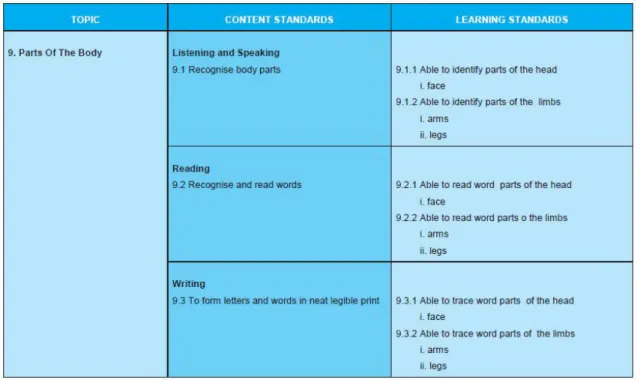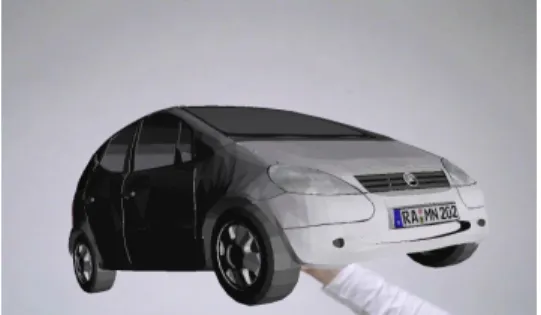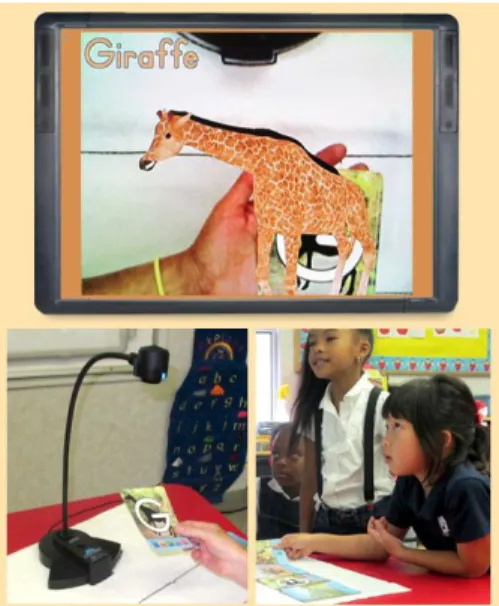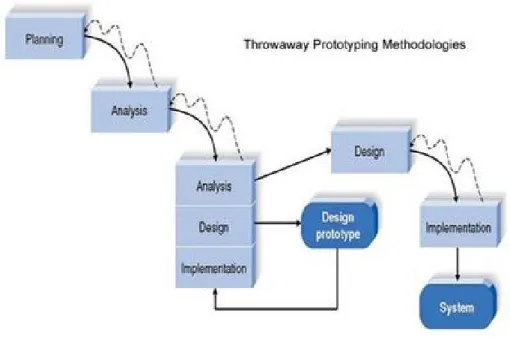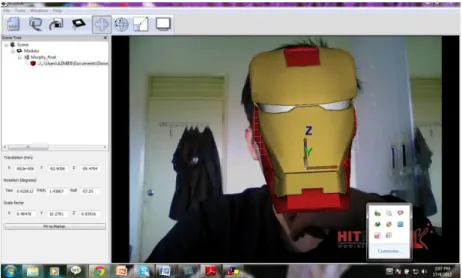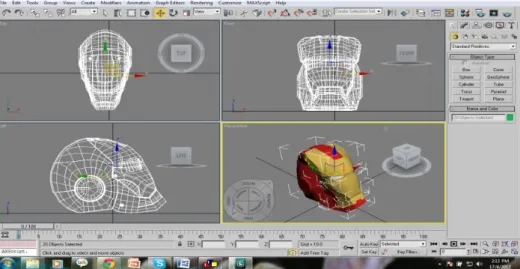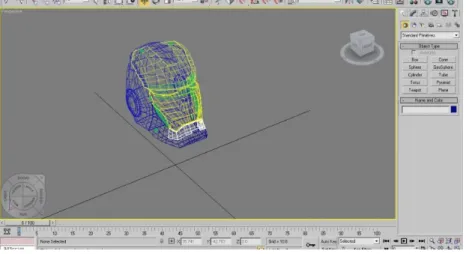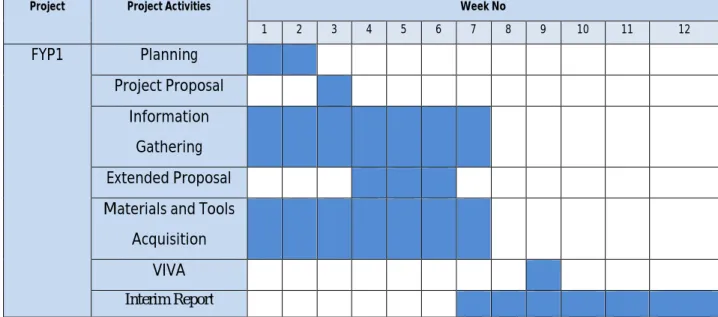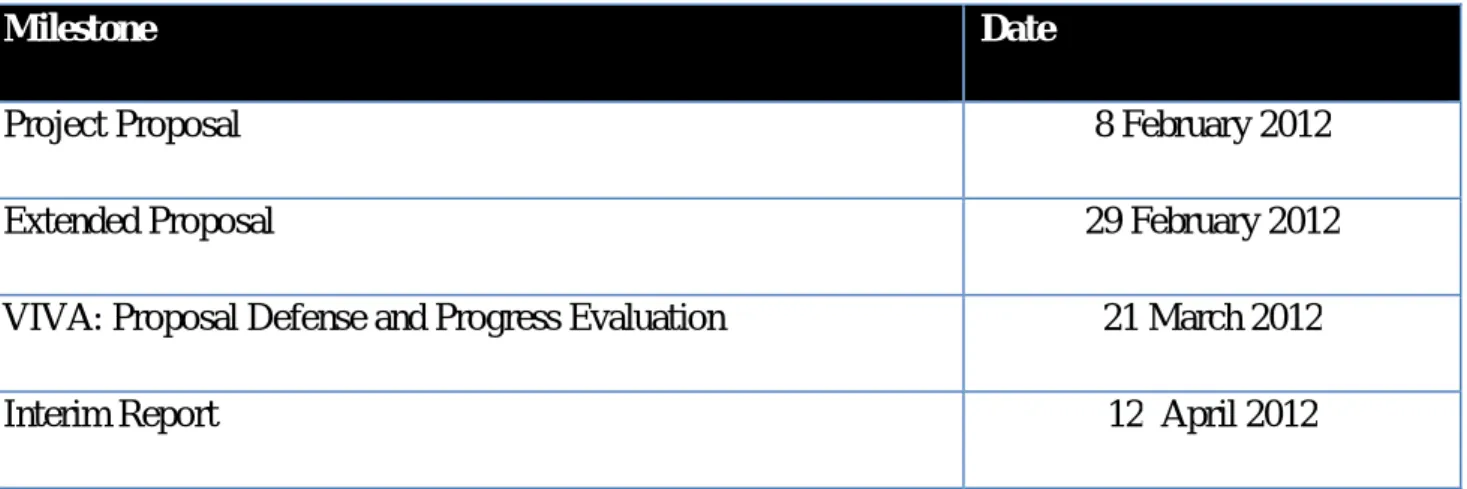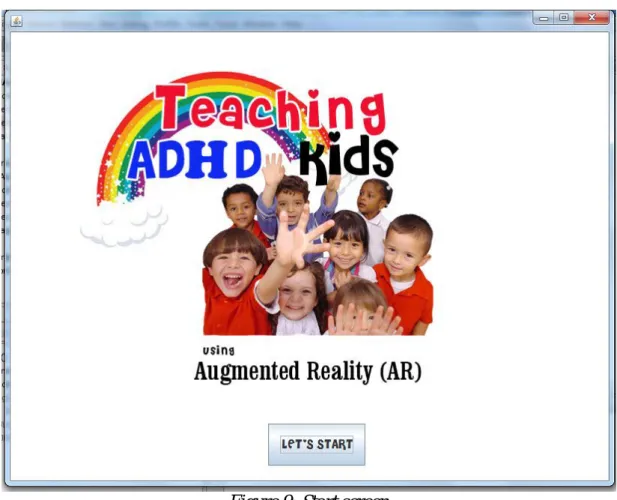Teaching ADHD Children using AR (ADHD-Edu)
by
Mohd Azmidi Bin Abdullah 12011
Dissertation submitted in partial fulfilment of the requirements for the
Bachelor of Technology (Hons) (Information Communication technology)
3 August 2012
Universiti Teknologi PETRONAS Bandar Seri Iskandar
31750 Tronoh
Perak Darul Ridzuan
CERTIFICATION OF APPROVAL
Teaching ADHD Kids Using Augmented Reality
By
Mohd Azmidi Abdullah
A project dissertation submitted to the
Information and Communication Technology Programme Universiti Teknologi PETRONAS
in partial fulfillment of the requirement for the BACHELOR OF TECHNOLOGY (Hons)
(INFORMATION AND COMMUNICATION TECHNOLOGY)
Approved by, ________________
(Dr. Dayang Rohaya Bt Awang Rambli)
CERTIFICATION OF ORIGINALITY
This is to certify that I am responsible for the work submitted in this project, that the original work in my own except as specified in the references and acknowledgements, and that the original work contained herein have not been undertaken or done by unspecified sources or persons.
________________________
MOHD AZMIDI BIN ABDULLAH
Abstract
Education for Attention Deficit Hyperactivity Disorder (ADHD-Edu) is learning software for Attention Deficit Hyperactivity Disorder (ADHD) children in pre-school by using augmented reality (AR) approach. By combining AR with current teaching tools such as computer and projector, learning environment will completely change into a new dimension. ADHD – Edu will help ADHD children getting as much input as possible compare to current teaching tools which are not compatible with their ability. With the interactive module in this software, ADHD children will learn effectively despite of their hyperactive behaviour.
Table of Contents
CHAPTER 1 INTRODUCTION ... 1
1.1 Background of Study ...Error! Bookmark not defined. 1.2 Problem Statement ... 2
1.3 Objective ... 2
1.4 Scope of Study ... 3
1.5 Relevancy of the Project ... 3
CHAPTER 2 LITERATURE REVIEW ... 4
2.1 Definition of ADHD ... 4
2.2 Symptoms of ADHD ... 5
2.3 Pre School ... 7
2.4 Curriculum Standard For Special Kids ... 8
2.5 Augmented Reality in Education ... 10
2.6 Proposed Solution ... 11
CHAPTER 3 METHODOLOGY ... 14
3.1 Choosing Software Development Methodology ... 14
3.2 Research Methodology ... 15
3.3 Tools ... 16
3.4 Key Milestones / Gant Chart ... 19
CHAPTER 4 RESULT ... 20
CHAPTER 5 CONCLUSION ... 23
REFERENCES .. ... 25
LIST OF FIGURES
Figure 1: English module component 9
Figure 2: English module component 10
Figure 3: Example of AR in SMART 11
Figure 4: Letter Alive 12
Figure 5: Throwaway Prototyping Methodologies 14
Figure 6:AR using BuildAR 17
Figure 7: Modelling using 3Ds Max 2009 18
Figure 8: Modelling using 3Ds Max 2009 18
Figure 9: Start screen 20
Figure 10: Configuration windows 21
Figure 11: Cmd windows 21
Figure 12: Example of program 22
LIST OF TABLES
Table 1: Milestone 19
Table 2: Gantt Chart 19
1
CHAPTER 1: INTRODUCTION 1.1 Background
Attention-deficit/hyperactivity disorder (ADHD) is a developmental, neurobiological condition defined by the presence of severe and pervasive symptoms of inattention, hyperactivity and impulsivity [1]. Screening for hyperactivity and inattention (the major symptoms of ADHD) in a community survey amongst Malaysian children and adolescents between the ages of 5 – 15 years showed a prevalence rate of 3.9 %. ADHD is three times more likely to occur in males. It is more common in males compared to females [3].
Children with a diagnosis of attention-deficit/hyperactivity disorder (ADHD) usually present with a wide range of characteristics and problems including academic underachievement and learning disabilities. In fact, it has been estimated that approximately 80% of children with ADHD experience academic underachievement and approximately one- third of children with ADHD have specific learning disabilities [8] [6].
ADHD can’t be cured. One method having been used to help ADHD relieved is stimulant medications making use of Ritalin, Dexedrine, Cylert. The other is behaviour therapy based on several simple and sensible notions about what leads children to behave in socially appropriate ways. But both two methods have some following disadvantages; side- effects (Ritalin can cause a cancer of liver [17]), needs of much time and efforts from many persons concerned. To overcome these disadvantages, we developed the learning system using Augmented Reality (AR) technology.
2
1.2 Problem Statement
Inattention, hyperactivity, and impulsivity are the core symptoms of Attention Deficit Hyperactivity Disorder (ADHD). A child’s academic success is often dependent on his or her ability to attend to tasks and teacher and classroom expectations with minimal distraction.
Such skill enables a student to acquire necessary information, complete assignments, and participate in classroom activities and discussions. When a child exhibits behaviours associated with ADHD, consequences may include difficulties with academics and with forming relationships with his or her peers if appropriate instructional methodologies and interventions are not implemented. Although many children have only ADHD, others have additional academic or behavioural diagnoses. For instance, it has been documented that approximately a quarter to one-third of all children with ADHD also has learning disabilities [11]. In conclusion, ADHD children have difficulties in learning because:
Tend to forget what they’ve learnt
Easily distracted
Current Teaching tools such as exercise book and homework is not effective enough for them.
• AR has many advantages over traditional manual-based and VR models in training and learning applications because users can see and touch the real objects, and at the same time have an interactive guided support to allow the users to work at their own pace. This support includes highlighting and sequencing specific objects in the users' field of view, depending on the task and the users' experience, or presentation of documentation. Furthermore, it would be possible for a remote expert to provide assistance by controlling the information displayed by the system [10].
3
1.3 Objective
The objectives of this project are:
Develop Augmented Reality learning software to assist ADHD children in pre- school.
Provide interactive and effective study environment for ADHD children to learn English using AR approach.
1.4 Scope of Study
There are three main elements in the scope of this project:
Pre-School Children with ADHD
The pre-school years are a key period of a child’s development, where the building blocks for later success are laid, and where social, behavioural and academic skills necessary for academic development are acquired [5]. Cases of ADHD tend to be concentrated in school-age children; however, research now shows that ADHD also exists in preschool children [12][4], adolescence[8][14] and in adulthood [15][12].
Augmented Reality (AR)
AR naturally draws people’s attention. Drawing students’ attention is an important factor in instruction. [11]
1.5 Relevancy of Project
The project is relevant to help ADHD children learning since the current teaching tools is not effective enough for them. AR provide new learning environment for them and build up their motivation to study. Hence, increase their academic performance.
4
1.6 Feasibility within Timeframe
The project development will take two semesters of study which is enough for the author to complete the development of the project. The first semester involving the planning, analysis and design phases and the expected output in this semester will help in the implementation phase next semester.
5
CHAPTER 2: LITERATURE REVIEW
2.1 Attention Deficit Hyperactivity Disorder (ADHD)
ADHD is a disorder in which a person has a difficulty to learn effectively, caused by the disorder that affects the brain's ability to receive and process information [7].
ADHD has three subtypes [1] [3]:
• Predominantly hyperactive-impulsive (ADHD-H)
– Most symptoms (six or more) are in the hyperactivity-impulsivity categories.
– Fewer than six symptoms of inattention are present, although inattention may still be present to some degree.
• Predominantly inattentive (ADHD-I)
– The majority of symptoms (six or more) are in the inattention category and fewer than six symptoms of hyperactivity-impulsivity are present, although hyperactivity-impulsivity may still be present to some degree.
– Children with this subtype are less likely to act out or have difficulties getting along with other children. They may sit quietly, but they are not paying attention to what they are doing.
Therefore, the child may be overlooked, and parents and teachers may not notice that he or she has ADHD
• Combined hyperactive-impulsive and inattentive (ADHD-C)
– Six or more symptoms of inattention and six or more symptoms of hyperactivity- impulsivity are present.
– Most children have the combined type of ADHD.
6
2.2 Symptoms of Attention Deficit Hyperactivity Disorder (ADHD)
The symptoms of ADD/ADHD usually exhibited before the age of seven [12]. There are three major symptoms of Attention Deficit Hyperactivity Disorder (ADHD), which are inattention, hyperactivity, and impulsivity [1]. ADHD can be defined by behaviours exhibited by the individuals.
Children who have symptoms of inattention may [12] [3][4]:
• Be easily distracted, miss details, forget things, and frequently switch from one activity to another
• Have difficulty focusing on one thing
• Become bored with a task after only a few minutes, unless they are doing something enjoyable
• Have difficulty focusing attention on organizing and completing a task or learning something new
• Have trouble completing or turning in homework assignments, often losing things (e.g., pencils, toys, assignments) needed to complete tasks or activities
• Not seem to listen when spoken to
• Daydream, become easily confused, and move slowly
• Have difficulty processing information as quickly and accurately as others• Struggle to follow instructions.
Children who have symptoms of hyperactivity may [12] [3][4]:
• Fidget and squirm in their seats
• Talk nonstop
• Dash around, touching or playing with anything and everything in sight
• Have trouble sitting still during dinner, school, and story time
7
• Be constantly in motion
• Have difficulty doing quiet tasks or activities
Children who have symptoms of impulsivity may [12] [3][4]:
• Be very impatient
• Blurt out inappropriate comments, show their emotions without restraint, and act without regard for consequences
• Have difficulty waiting for things they want or waiting their turns in games
• Often interrupt conversations or others’ activities.
2.3 Pre School
In Malaysia, Ministry of Education has set certain requirements for Malaysian children to enter preschool. The requirements are:
I. For Malaysian only.
II. A child who reaches the age of five years on the first day of January in the year during his schooling. (1 Jan 2010)
III. According to per capita income on the income poverty line (Garis Kemiskinan).
IV. Merit based on income ranking parent / guardian from low to high. Rate for each class the student is not more than 25 people.
V. Preschool student selection process shall be made by the preschool committee.
8
2.4 Curriculum Standard for Special Kids
Under MOE there are two categories of special education programmes,
i) Special Schools for students with visual, auditory and learning disabilities (secondary level),
ii) Special Education Integration Programme for students with visual, auditory and learning disabilities –employs both isolated and partially inclusive teaching and learning approaches (primary, secondary and vocational levels).
In the secondary level the students are able to either follow the national curriculum or opt for vocational courses. The Special Schools are administered by the Ministry’s Special Education Division. The Special Education Integration Programmes at primary and secondary schools levels are administered by the State Education Department. For the Special Education Integration Programme in technical and vocational schools are administered by the Ministry’s Special Education Division, responsible for matters pertaining to policy and content.
Education for special needs children is also provided through community centres. These centres focus on providing education to students with more severe disabilities. The students are trained with living and basic vocational skills so that they could live independently and secure employment. These community centres are run by social welfare department. Many efforts are taken by the government to enhance the education quality for the special education students including allocation of generous amount of money to enhance the usage of ICT.
9 Malaysia government through Ministry of Education has drafted a special curriculum standard for special kids in level 1(year 1-3). The modules were categorized in 3 sections according to disabilities. The modules were divided into:
I. Learning problem II. Hearing problem III. Vision problem
In level 1 (year 1-3), they will learn 5 subjects which are:
I. Asas 3M (Menulis, membaca, mengira) / 3M basic (writing, reading, calculating)
II. Pengurusan kehidupan / Life Management III. Pendidikan Jasmani / Physical Education IV. Pendidikan Islam/ Islamic Education
V. Pendidikan Moral/ Moral Education
VI. Pendidikan Seni Kreatif/ Creative Art Education.
Figure 12 and figure 13 showed the component of English module that will be taught to student. Since this project only focusing on English subject, only the English module showed.
Figure 1: English Module Component
10 Figure 2: English Module Component
2.5 Augmented Reality
Augmented reality (AR) is related to the concept of virtual reality (VR). Both of the concepts enable a person to experience and explore interactively, predominantly through his or her sense of vision, but also via studio, tactile and other forms of feedback. The main point that differentiate between both of them is VR attempts to create an entirely artificial environment while AR aims to blend the virtual objects into the real world [13].
AR systems can either be marker-based or markerless- based. Marker-based applications are comprised of three basic components which include a booklet for offering marker information, a gripper for getting information from the booklet and converting it to another type of data, and a cube for augmenting information into 3D-rendered information on a screen. On the other hand, markerless-based applications need a tracking system that involves GPS (Global Positioning System), a compass, and an image recognition device instead of the three elements of maker-based systems. Markerless applications have wider applicability because they function anywhere without the need for special labelling or supplemental reference points [20].
11
2.6Augmented Reality in Education
The implementation of augmented reality in education has grown rapidly and being implemented in various level of education from primary school to higher learning institute.
AR has strong potential to provide both powerful contextual, on-site learning experiences and serendipitous exploration and discovery of the connected nature of information in the real world [20].
The combination of AR technology with the education contents gives birth to a new type of automated applications and act to enhance the effectiveness and attractiveness of teaching and learning for students in a real life scene. The technology provides a simple way of progressing to the teaching, learning and training in education. It promotes ‘active’
training, both in the psychological and physical sense, and will encourage the users to have diverse thinking perspectives, which should prepare them better for their other day-to-day activities [10].
Advancement of technology has created a lot of learning software for children. One of them SMART (System of Augmented Reality for Teaching). SMART puts children exploring concepts like means of transportation, types of animals and similar semantic categories through the use of a set of racquets that are used to manipulate a TV-show style game with 3D models which are superimposed to the real time video feed of the whole class. Several experiments were performed with 54 students in three different schools in Portugal. The results of studies indicated that SMART helps increase motivation among students, and it has a positive impact on the learning experiences of these students, especially among the less academically successful students [22].
Figure 3: Example of AR in SMART
12 Another brilliant idea based on augmented reality in education is Letters alive™.
Education's first classroom curriculum based on "augmented reality" technology attracted huge crowds at just-completed educational technology conferences in Florida and Texas.
Pioneered by Logical Choice Technologies, Letters alive™ - a new phonics curriculum for children learning to read-has seemingly-alive animals popping up in the hands of students and even responding to student questions and actions. Teachers and administrators in attendance were taken aback by the mind-blowing interactivity and intelligence of the virtual animals. Educators recognized the profound impact the curriculum could have on learning not only with pre-k and kindergarten students, but also with English Second Language (ESL) and Special Needs students [9]. The “Letters alive” Augmented Reality teaching cards and software work in conjunction with four common classroom technologies:
Teacher’s laptop (PC or Mac)
Compatible USB document camera
Classroom audio system
Digital projector and screen or an interactive whiteboard
Figure 4: A kindergartener interacting with a virtual 3D giraffe from the new Letters alive™ reading curriculum.
Source: http://www.logicalchoice.com
13
2.7 Proposed Solution
By implementing AR element in ADHD-Edu, ADHD children will experience an effective and interactive learning environment.
They will learn English subject in a new way which more interactive. For beginning the will learn about body parts.
Once they have chosen the module, what they need to do is they just have to stand in front of camera. The markers attached to their body will display the word, for example hand.
The marker actually did not place in right position. The marker on their hand might be display the word head. So, they need to arrange and place the marker into correction position.
14
CHAPTER 3: METHODOLOGY
3.1 Choosing Software Development Methodology
The project will be using Throwaway Prototyping that is falls under the rapid application development (RAD) based methodology. Throwaway prototyping based methodology is similar to prototyping methodology with difference that it will be done at different phase of system development life cycle (SDLC).
Throwaway prototyping is basically intended to help users to visualize how the module looks after it being built. This type of methodology is also known as Dummy (mock- up) prototype as it will be a presentation before implementing the real finish module. The phases of this methodology are based on system development life cycles which consist of 4 phase which are planning, analysis, design and implementation. As for throwaway prototype, it will relies on few design prototypes during the analysis and design phases before continue with the implementation phase.
Figure 5: Throwaway Prototyping Methodologies
15
3.2 Research Methodology
There were few data gathering methodology is being implemented to get all information that is relate and relevant with the project title. The information is obtained from few sources such as:
World Wide Web (www)/internet: Internet provides a lot of related information. The research result, information yielded from internet is most helpful tool to find idea for the project. Their research and journal are produce by the experts in their own field can be obtained through journal database such as:
i. Springer ii. IEEE iii. ACM
iv. Science Direct
Google advance search is powerful tools to search information easier.
UTP Information Resource Centre (UTP IRC)
UTP IRC provides book and journal to be borrowed by students for reading and research purposes. There are several books that related with the project that can be found at UTP IRC.
16
3.3 Tools
AR development ARToolKit
ARToolKit is a software library for building Augmented Reality (AR) applications. That these are applications involve the overlay of virtual imagery on the real world. For example, in the image to the right a three-dimensional virtual character appears standing on a real card.
It can be seen by the user in the head set display hire are Wearing. When the user moves the card, the virtual character moves with it and appears attached to the real object.
One of the key difficulties in developing Augmented Reality applications is the problem of tracking the users viewpoint. In order to know from what viewpoint to draw the virtual imagery, the application needs to know where the user is looking in the real world.
ARToolKit uses computer vision algorithms to solve this problem. The ARToolKit video tracking libraries calculate the real camera position and orientation relative to physical markers in real time. This enables the easy development of a wide range of Augmented Reality applications. Some of the features of ARToolKit include:
Single camera position/orientation tracking.
Tracking code that uses simple black squares.
The ability to use any square marker patterns.
Easy camera calibration code.
Fast enough for real time AR applications.
SGI IRIX, Linux, MacOS and Windows OS distributions.
Distributed with complete source code.
17 Hardware
PC
Webcam or digital camera
Projector (optional)
Graphics development
Blender
Blender is used to create 3D object that is more complex for AR. The finished object will be published according to certain standard format that compatible with Android to be exported. This tools help to counter the problem of drawing 3D object programmatically using OpenGL ES.
Autodesk 3ds Max 2009
Autodesk 3ds Max, formerly 3D Studio Max, is 3D computer graphics software for making 3D animations, models, and images. It was developed and produced by Autodesk Media and Entertainment. It has modelling capabilities, a flexible plug in architecture and can be used on the Microsoft Windows platform. It is frequently used by video game developers, TV commercial studios and architectural visualization studios. It is also used for movie effects and movie pre-visualization.
Figure 6: AR using BuildAR
18 For this project 3ds Max is used to export the 3D model into .3Ds which is readable by BuildAR.
Figure 7: Modelling using 3Ds Max 2009
Figure 8: Modelling using 3Ds Max 2009
19
3.4
Key Milestones / Gant ChartThe key milestones that need to be achieved in the first semester of Final Year Project (FYP) are as below and refer Gantt chart at the attachment.
Milestone Date
Project Proposal 8 February 2012
Extended Proposal 29 February 2012
VIVA: Proposal Defense and Progress Evaluation 21 March 2012
Interim Report 12 April 2012
Project Project Activities Week No
1 2 3 4 5 6 7 8 9 10 11 12
FYP1 Planning
Project Proposal Information
Gathering Extended Proposal Materials and Tools
Acquisition VIVA Interim Report
Table 1: Milestones
Table 2: Gantt chart
20
CHAPTER 4: RESULT
4.1 Result
This is the home screen. Whenever user click on .exe file it will show this screen.
They will navigate to next page when they click on “Let’s start” button.
Figure 9: Start screen
21 When user start the AR program, this pop up will shown. On this window the user can configure and edit the setting such as frame rate and output size of the program.
Figure 10: Configuration
The cmd window shows the information of the object being rendered.
Figure 11: Cmd windows
22 Figure 12: Example of program
23
CHAPTER 5: CONCLUSION
5.1 Conclusion
This project is helping children with ADHD to learn and understand what have been taught by teacher. Pre-school children are the target because at this stage the children with ADHD start to exhibit the symptoms. This project is not meant to cure the ADHD children but to help them understand and not left behind in class. With the learning module according to pre school curriculum ADHD-Edu will improve their academic performance and overcome the disabilities.
5.2 Future Work
A person still can have ADHD even they are growing up and become adult. For future work ADHD-Edu will expand the target to adult. New learning module will develop
according to high school curriculum and with more interactive application.
24
5.1 Flow Chart
Yes
No
Main menu
Choose Module
My Body
Continue Module?
End Start
25 REFERENCES
1. American Psychiatric Association (1994) Diagnostic and Statistical Manual of Mental Disorders (DSM-IV), 4th edn. American Psychiatric Association, Washington, DC, USA.
2. Barkley, R. A., Fischer, M., Smalllish, L. & Fletcher, K. (2002) Thepersistence of attention-deficit/hyperactivity disorder into young adulthood as a function of reporting source and definition of disorder. Journal of Abnormal Psychology, 111, 279–289.
3. Barkley, R. A. (2006). Attention Deficit Hyperactivity Disorder: A handbook for diagnosis and treatment, 3rd Ed. New York: Guilford Press
4. Daley, D., Jones, K., Hutchings, J. & Thompson, M. (2009) Attention deficit hyperactivity disorder (ADHD) in pre-school children, current findings, recommended interventions and future directions. Child: care, health and development, DOI: 10.1111/ j.1365-2214.2009.00938.
5. Daley, D., & Birchwood, J. (2010). ADHD and academic performance: why does ADHD impact on academic performance and what can be done to support ADHD children in the classroom? ADHD and academic performance , 455–464.
6. DuPaul, G. J. & Volpe, R. J. (2009). ADHD and Learning Disabilities: Research Findings and Clinical Implications. Current Attention Disorders Reports, 1, 152–
155.
7. Eicka L.Wodka, Chritopher Loftis, Stewart H.Mostofsky, Christine Prahme, Jennifer C. Gidley Larson, Martha B. Denckla, E. Mark Mahone “Prediction of ADHD in boys and girls using D-KEFS”,2007 oxford journal clinical neuropsychology 2008 23(3):283-293
8. Faigel, H. C., Sznajderman, S., Tishby, O., Turel, M. & Pinus, U.(1995) Attention deficit disorder during adolescence – a review. Journal of Adolescent Health, 16, 174–184.
9. Forness, S. R., & Kavale, K. A. (2001). ADHD and a return to the medical model of special education. Education and Treatment of Children, 24(3), 224–247.
10. Freitas, R., & Campos, P. (2008). SMART: a System of augmented reality for teaching 2nd grade students. Proceedings of the 22nd British Computer Society Conference on Human-Computer Interaction (HCI 2008), 27-30. Liverpool John Moores University, UK.
11. Gagne, R. M., Briggs, L. J. and Wager, W. W. 1992. Principles of instructional design. Harcourt Brace Jovanovich College Publishers
12. Helen, W., Sydney, S., & Terry, L. (2007). IDC 2007 Proceedings: Input Technologies. Use of Images in Instructional Technology for Children with Attentional Difficulties , 129-132.
26 13. Hollere, T. H., & Feiner, S. K. (2004). Mobile Augmented Reality.
Telegeoinformatics: Location-Based Computing and Services , 1, 6.
14. Johnson, L., Levine, A., Smith, R., & Stone, S. (2010).Simple augmented reality. The 2010 Horizon Report, 21-24. Austin, TX: The New Media Consortium.
15. Lavigne, J. V., Gibbons, R. D., Christoffel, K. K., Arend, R., Rosenbaum, D., Binns, H., Dawson, N., Sobel, H. & Isaacs, C. (1996) Prevalence rates and correlates of psychiatric disordersamong preschool children. Journal of the American Academy of Child and Adolescent Psychiatry, 35, 204–214.
16. LogicalChoiceTech. (13 February, 2011). Letters alive™ Reading Curriculum:
Augmented reality that makes learning to read fun! Retrieved 29 March, 2012, from Youtube: http://www.youtube.com/watch?v=52j_l4eRp_w
17. Mannuzza, S., Klein, R. G., Bessler, A., Malloy, P. & LaPadula, M. (1993) Adult outcome of hyperactive boys: educational achievement, occupational rank, and psychiatric status. Archives of General Psychiatry, 50, 565–576.
18. Melinda Smith, M. a. (JUNE, 2007). ADD / ADHD in Children. Retrieved 28 MARCH, 2012, from HELPGUIDE.ORG:
http://www.helpguide.org/mental/adhd_add_signs_symptoms.htm#authors
19. National Institute of Mental Health. (2008). Attention Deficit Hyperactivity Disorder (ADHD). NIH Publication.
20. Peter Montague, “ADHD and Children’s Environment”, Rachel’s Environment &
Health Weekly #678, December 2,1999 (17)
21. Toh et al., Psychiatric Morbidity in Children and Adoelscents. in National Health and Morbidity Survey III. 2006, Ministry of Health Malaysia.
22. U.S. Department of Education. (2008). Identifying and treating Attention Deficit Hyperactivity Disorder : A Resource for School and Home. Jessup: U.S. Department of Education.
23. Weng, N. (2008, July 3). Technology News. Retrieved march 29, 2012, from Research: http://www.researchsea.com/html/article.php/aid/3324/cid/2 24. Wolraich, M. L., Wibbelsman, C. J., Brown, T. E., Evans, S.W., Getlieb, E. M.,
Knight, J. R., Ross, E. C., Shubiner, H. H., Wender, E. H. & Wilens, T. (2005)
Attention-deficit/hyperactivity disorderamong adolescents: a review of the diagnosis, treatment, and clinical implications. Pediatrics, 115, 1734–1746.
27
APPENDIXES
(Please refer to the next pa
